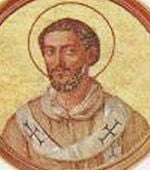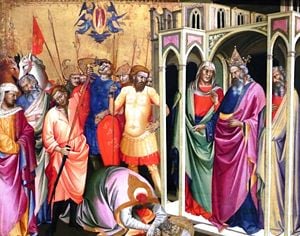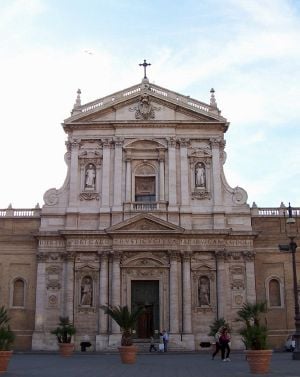Difference between revisions of "Pope Caius" - New World Encyclopedia
m |
m |
||
| Line 20: | Line 20: | ||
==Biography== | ==Biography== | ||
| − | [[Image: | + | [[Image:Martyrdom of Pope Caius.jpg|thumb|300px|left|Depiction of the martyrdom of Pope Caius, by [[Lorenzo Monaco]]. Today, the Catholic Church lists Caius as a [[confessor]], but not a [[martyr]], as the persecution of Christians by [[Emperor Diocletian]] is thought to have begun after Caius' death.]] |
Caius was said to have been born in the [[Dalmatia]]n city of [[Salona]], today known as Solin near [[Split]]. He was the son of a man also named Caius. According to a sixth-century account, two brothers named Caius and Gabinus, prominent and wealthy members of the Roman church, established an Christian house of worship in their house on the site of [[Santa Susanna]]. It it believed that this Caius may have the future pope, or [[Caius (presbyter)|Caius the Presbyter]]. | Caius was said to have been born in the [[Dalmatia]]n city of [[Salona]], today known as Solin near [[Split]]. He was the son of a man also named Caius. According to a sixth-century account, two brothers named Caius and Gabinus, prominent and wealthy members of the Roman church, established an Christian house of worship in their house on the site of [[Santa Susanna]]. It it believed that this Caius may have the future pope, or [[Caius (presbyter)|Caius the Presbyter]]. | ||
Gabinus is also the name given to the father of Saint Susanna. Thus, Pope Caius has been traditionally seen as the uncle of Susanna. However, other accounts indicate that Caius, the uncle of Susanna, was the Roman prefect (governor) at the time. | Gabinus is also the name given to the father of Saint Susanna. Thus, Pope Caius has been traditionally seen as the uncle of Susanna. However, other accounts indicate that Caius, the uncle of Susanna, was the Roman prefect (governor) at the time. | ||
| − | |||
During his pontificate, [[anti-Christian]] new churches were built and cemeteries were expanded. The Novatianist schism continued to challenge the Catholic Church, and gnostic teachings also competed with Christianity for the spiritual loyalty of the residents of Rome. The [[Manicheans]] in particular had developed a strong presence in the captial. | During his pontificate, [[anti-Christian]] new churches were built and cemeteries were expanded. The Novatianist schism continued to challenge the Catholic Church, and gnostic teachings also competed with Christianity for the spiritual loyalty of the residents of Rome. The [[Manicheans]] in particular had developed a strong presence in the captial. | ||
| Line 33: | Line 32: | ||
==Legacy== | ==Legacy== | ||
| − | [[Image: | + | [[Image:Santa Susanna (Rome) - facade.jpg|thumb|Site of the current Santa Susana in Rome, where Caius may have established an early Christian house-church]] |
| + | Originally part of the altarpiece of the church of San Gaggio in Florence.]] Caius is mentioned in the fourth-century ''Depositio Episcoporum'' in which he is listed as a Roman bishop but not a martyr. Caius' tomb, with the original epitaph, was discovered in the [[Catacomb]]s of [[Pope Callixtus I|Callixtus]]. Also discovered was his [[signet ring]]. | ||
In 1631, his supposed residence in [[Rome]] was turned into a church. However, it was demolished in 1880 to make room for the [[Italian Minister of Defense|Ministry of War]], on the [[Via XX Settembre]], and his relics were transferred to the chapel of the [[Barberini]] family. | In 1631, his supposed residence in [[Rome]] was turned into a church. However, it was demolished in 1880 to make room for the [[Italian Minister of Defense|Ministry of War]], on the [[Via XX Settembre]], and his relics were transferred to the chapel of the [[Barberini]] family. | ||
Revision as of 21:08, 16 January 2009
| Saint Caius | |
|---|---|

| |
| Birth name | Caius or Gaius |
| Papacy began | December 17, 283 |
| Papacy ended | April 22, 296 |
| Predecessor | Eutychian |
| Successor | Marcellinus |
| Born | ??? ??? |
| Died | April 22, 296 ??? |
Pope Saint Caius or Gaius was Pope from December 17, 283 to April 22, 296. Christian tradition makes him a native of the Dalmatian and a member of a noble family related to the Emperor Diocletian. However, his history is clouded by later legend which associates him anachronistically with Saint Susanna and Saint Sebastian, who died during the persecutions of Diocletian after Caius' papacy had ended.
Little other information on Caius is available except that given by the Liber Pontificalis, which is not considered historically reliable. According to legend, Caius baptized the men and women who had been converted by Saint Tiburtius and Saint Castulus. He is also thought to have been the Caius who donated a house for the church's use in Rome, which was later turned into the historic Church of Santa Susanna, which stands today at the site.
His legend states that Caius took refuge in the catacombs of Rome and died a martyr. However, as his episcopacy dates from a period of peace with the Roman state, this report is generally dismissed by modern scholars. The Catholic Church today recognizes him as a "confessor" but not as a martyr. His feast day is marked on April 22 together with that of Pope Saint Soter.
Biography

Caius was said to have been born in the Dalmatian city of Salona, today known as Solin near Split. He was the son of a man also named Caius. According to a sixth-century account, two brothers named Caius and Gabinus, prominent and wealthy members of the Roman church, established an Christian house of worship in their house on the site of Santa Susanna. It it believed that this Caius may have the future pope, or Caius the Presbyter.
Gabinus is also the name given to the father of Saint Susanna. Thus, Pope Caius has been traditionally seen as the uncle of Susanna. However, other accounts indicate that Caius, the uncle of Susanna, was the Roman prefect (governor) at the time.
During his pontificate, anti-Christian new churches were built and cemeteries were expanded. The Novatianist schism continued to challenge the Catholic Church, and gnostic teachings also competed with Christianity for the spiritual loyalty of the residents of Rome. The Manicheans in particular had developed a strong presence in the captial.
Diocletian took up the office of emperor in 284, and imperial policy under his rule began to emphasize the imperial cult and threaten the toleration shown the Christians since the edict of Emperor Gallienus in 260. However, actual persecution of Christians under Diocletian does not seem to have begun in Cauis' time. In 299, the army was purged of Christians, and in 302, Diocletian condemned all Manicheans to death. Diocletian’s persecution of Christians began in 303 C.E., and thus the report of Caius martyrdom is today treated as probably unfounded.
The Liber Pontificalis claims that, as pope, Cauis decreed that before someone could assume the position of bishop, he must first be porter, lector, exorcist, acolyte, subdeacon, deacon, and priest. He is also also divided the districts of Rome among the deacons. Both claims, however, are generally viewed as historically unreliable.
Legacy
Originally part of the altarpiece of the church of San Gaggio in Florence.]] Caius is mentioned in the fourth-century Depositio Episcoporum in which he is listed as a Roman bishop but not a martyr. Caius' tomb, with the original epitaph, was discovered in the Catacombs of Callixtus. Also discovered was his signet ring.
In 1631, his supposed residence in Rome was turned into a church. However, it was demolished in 1880 to make room for the Ministry of War, on the Via XX Settembre, and his relics were transferred to the chapel of the Barberini family.
The site of the house-church thought to have been established by Caius and Gabinus, however, is still home to the Church of Santa Susanna. It is first mentioned in this historical sources in connection with a Roman synod of 499.
Traditionally, the structure is believed to have become a church devoted solely to worship around 330, under Constantine I, when numerous large house-churches came to be adapted for strictly liturgical use. The basilica was T-shaped with a central nave with twelve columns on each side, flanked by side aisles. All that is left of the earlier structure after the late sixteenth-century rebuilding are the two side chapels of the basilica church.
From the records of a Roman synod of 565, the church appears under the titulus church of Susanna. Pope Sergius I renovated the church at the end of the seventh century. Pope Leo III, the fourth pope who had been pastor of this church, rebuilt it from the ground in 796, adding the great apse and conserving the relics of the saints in the crypt. A vast mosaic of Christ flanked by Leo and the Emperor Charlemagne on one side and Saints Susanna and Felicity on the other was so badly damaged in the twelfth century by an earthquake that the interior was plastered over in a complete renovation that spanned the years 1585–1602, during which time and frescoes were added by Cesare Nebbia (1536–1614).
The present church of Santa Susanna was the first independent commission in Rome for Carlo Maderno. In 1603, Maderno completed the façade, a highly influential early Baroque design. The dynamic rhythm of columns and pilasters, crowding centrally, and the protrusion and increased central decoration add further complexity to the structure.
Veneration
In Florence, the Church of San Gaggio on the via Senese was dedicated to him. However, in 2003, plans were put into effect to turn it into residential council housing.[1] Saint Caius is portrayed in art wearing the papal tiara. He is venerated in Dalmatia and Venice.
Saint Caius's feast day is on April 22, commemorated together with that of Pope Saint Soter. They were celebrated jointly in the Tridentine Calendar and in the successive versions of the General Roman Calendar until that of 1969, since when they are omitted.
However, both popes are mentioned under April 22 in the Roman Martyrology, the official list of recognized saints. The entry for Saint Caius is as follows: "At Rome, in the cemetery of Callistus on the Via Appia, the burial of Saint Caius, Pope, who, fleeing from the persecution of Diocletian, died as a confessor of the faith."[2]
| Roman Catholic Popes | ||
|---|---|---|
| Preceded by: Eutychian |
Bishop of Rome Pope 283–296 |
Succeeded by: Marcellinus |
Notes
- ↑ Firenze la città nuova - Gallery
- ↑ Martyrologium Romanum (Libreria Editrice Vaticana, 2001. ISBN 8820972107)
ReferencesISBN links support NWE through referral fees
External links
 "Caius and Soter, Saints and Popes" in the 1913 Catholic Encyclopedia.
"Caius and Soter, Saints and Popes" in the 1913 Catholic Encyclopedia.- Opera Omnia by Migne patrologia Latina
- (Italian) San Caio
| ||||||||||||||||
| |||||||||||||||||||||||||||||||||||||||||||||
| |||||||||||||||||||||||||||||||||||||||||
Credits
New World Encyclopedia writers and editors rewrote and completed the Wikipedia article in accordance with New World Encyclopedia standards. This article abides by terms of the Creative Commons CC-by-sa 3.0 License (CC-by-sa), which may be used and disseminated with proper attribution. Credit is due under the terms of this license that can reference both the New World Encyclopedia contributors and the selfless volunteer contributors of the Wikimedia Foundation. To cite this article click here for a list of acceptable citing formats.The history of earlier contributions by wikipedians is accessible to researchers here:
The history of this article since it was imported to New World Encyclopedia:
Note: Some restrictions may apply to use of individual images which are separately licensed.


